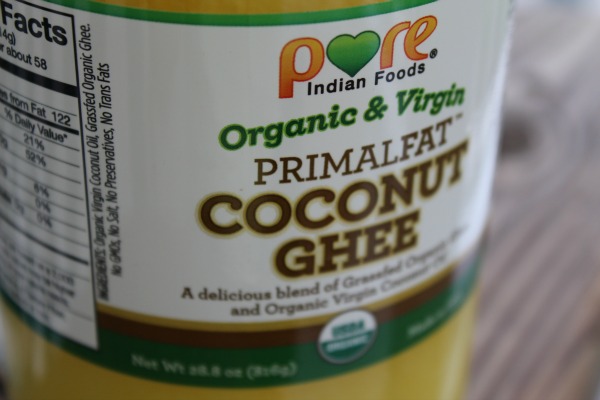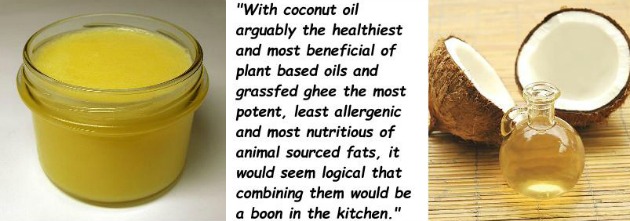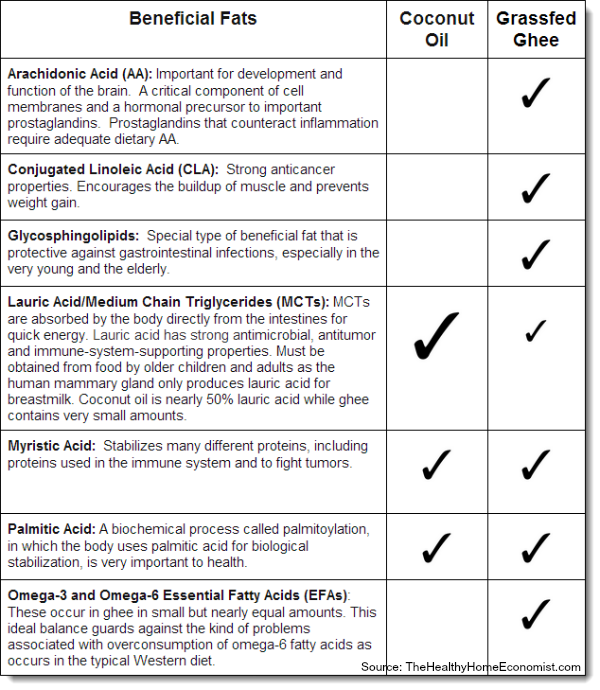Choosing the right fat for cooking and baking is absolutely essential to the overall success of a dish – not just in how it tastes, but how you feel after eating it.
Restaurants and bakeries today overwhelmingly use polyunsaturated vegetable fats for food preparation. These oils should never be heated at all let alone used for cooking or baking. Unless cold-pressed, these factory fats are already rancid in the bottle right off the store shelf, and even if a cold-pressed oil is used, the oil is destroyed and full of free radicals by the time the food is cooked with is served up on your plate.
Cooking requires fats that will maintain their integrity when heated and nourish the body rather than burden it with toxins.
For these reasons, both coconut oil and ghee have been perennial favorites in my kitchen for years.
Benefits of Coconut Oil
Coconut oil is full of medium-chain triglycerides (MCTs), which the body absorbs directly from the small intestines for quick energy. It is less likely to cause weight gain than polyunsaturated oils and has strong antimicrobial effects. MCTs are increasingly being utilized as nutritional therapy for those with Alzheimer’s, Parkinson’s, multiple sclerosis and other debilitating neurological diseases.
Coconut oil is highly stable, unlike polyunsaturated vegetable oils, so much so, that you can keep it unrefrigerated in your pantry for years and it will not go rancid (I have a 5-gallon bucket in my garage. It stays perfect through the long, hot, humid Florida summers). It remains stable and does not readily form free radicals even when heated making it an ideal cooking oil.
Ghee Advantages
Ghee is simply a must in the pantry of any Traditional Cook. Clarified butter as it is also known, has been used for thousands of years by Indian cultures for cooking. Traces of ghee have been found on fragments of Indian pottery dating as far back as 6500 BC!
Even those with a dairy allergy usually find ghee presents no trouble for them. This is because removing all the milk solids (proteins like casein) as well as the milk sugar (lactose) from the butter during the clarification process renders ghee a nonallergenic oil.
In addition, any water that is present is completely removed from butter when ghee is made which when combined with the removal of the milk proteins and lactose, greatly increases the smoke point. This makes ghee ideal for even high heat cooking as the purest ghee has a smokepoint of up to 485 F/252 C. According to my research, only refined avocado oil has a higher smokepoint than ghee.
Like coconut oil, ghee does not need refrigeration and keeps well on the counter or pantry for many months.
Note that ghee and butter oil are sometimes confused. The two are slightly different as butter oil is made from raw butter and ghee is usually not.
Best of the Best: Coconut Oil Blended with Ghee
 With coconut oil arguably the healthiest and most beneficial of plant-based oils and ghee the most potent, least allergenic and most nutritious of animal-sourced fats, it would seem logical that combining them would be a boon in the kitchen.
With coconut oil arguably the healthiest and most beneficial of plant-based oils and ghee the most potent, least allergenic and most nutritious of animal-sourced fats, it would seem logical that combining them would be a boon in the kitchen.
This is exactly what I discovered when I tried using a ghee/coconut oil blend for the first time. I love the intense butter flavor that ghee gives to food. At the same time, I also enjoy the moistness that coconut oil provides, particularly to baked goods.
Using this oil blend works beautifully for sauteing, frying up pancakes, cooking vegetables, and stir-frying. Higher heat uses such as grilled cheese sandwiches work too. Blending the ghee with coconut oil increases the smokepoint of the coconut oil so that the overall smokepoint of the blended oil is higher than coconut oil alone.
Healthy Array of Fats in Coconut Ghee
The beneficial fats in a quality Coconut Ghee blend made with virgin coconut oil and grass-fed ghee are many. Here are the main ones along with how they boost our health:
How to Best Use Coconut Ghee in the Kitchen
In summary, blending organic virgin coconut oil and grass-fed organic ghee together results in a nutritional powerhouse of fats. It not only delights the tastebuds, but it is healthful as well!
Here are a few ideas to get you started on how to optimally use this blended fat in your kitchen routine:
- Try using coconut ghee for sauteing vegetables or your favorite stir-fry.
- Use coconut ghee for all your baking needs. The intense butter flavor of the ghee combined with the moistness provided by the virgin coconut oil makes for the best pastries, bread, and cookies you’ve ever tasted.
- The high smokepoint of coconut ghee makes it suitable even for frying. Grilled cheese sandwiches and tuna melts made with coconut ghee are favorites in my home.
- Coconut ghee works well for those who follow a Paleo/Primal diet. Almond flour pizza crust, coconut flour pancakes, and grain-free cobblers all turn out moist and delicious using coconut ghee.
Where to Source Quality Coconut Ghee
The best coconut ghee is blended at a ratio of 1:1 in order to obtain equal benefit from each healthy fat. This proportion also minimizes the coconut flavor from the virgin coconut oil.
You can certainly go the DIY homemade ghee route by gently heating grass-fed butter. Skim to remove all the milk solids. Then, carefully blend in an equal amount of virgin coconut oil.
While this process is easy, it is a bit time-consuming. As a result, I was happy to discover a source for coconut ghee that is as high quality as anything I would make myself.
PRIMALFAT Coconut Ghee from Pure Indian Foods combines organic virgin coconut oil with grass-fed organic ghee in a very smooth, high-quality blend. The pastured butter used to make the ghee comes only from cows eating rapidly growing Spring and Fall grass. This is the most nutrient-dense pasture possible.
Coconut Ghee is a perfectly nutritious and delicious cooking fat for anyone who espouses Traditional Diet including those with a Paleo/Primal dietary preference.
Two sizes are available, a 14.2 oz jar and a 28.8 oz family size. I prefer the larger size as I tend to do batch cooking to save time.
If you’ve been using pastured butter and coconut oil in your kitchen, try the PRIMALFAT Coconut Ghee. It works beautifully for any and all cooking and baking needs. Taste for yourself the improved flavor and texture of food cooked with a blend of the most beneficial fats from both plant and animal sources.
References
(1) The Skinny on Fats
(2) Eat Fat Lose Fat, by Dr. Mary Enig and Sally Fallon Morell
Pure Indian Foods paid a sponsorship fee for this post. However, the views and opinions expressed are solely those of The Healthy Home Economist.










What are the benefits to using about 2T ghee and/or coconut oil in a cup of coffee?
Wow, this is fabulous! Thanks, Sarah. I can’t wait to mix some up and get cooking and baking with it. I have been making my own ghee forever, but don’t use coconut oil near enough, for various reasons. Now I have a way to get more of it in on a regular basis. And I didn’t realize coconut oil produced such great results in baked goods.
Good morning just bought some organic coconut oil & ghee by Carrington Farms. I really like it on toast but have not tried with other things yet. I have high cholesterol and cannot take statins drugs. My alternative is diet and exercise. So interested in anything that can help me in this journey.
Sarah, do you have a recipe/tutorial for making your own ghee? I’d love to make my own if it’s cheaper than buying this product. I don’t mind the time. 🙂 Thanks!
Thanks Sarah for this post. I had tried ghee, the Purity farms brand, but it tasted so awful that I was definitely not sold on ever using ghee. -Until I tried the Primalfat you recommended in this post. This stuff is delicious! I’m definitely sold on this one. It even convinced me to try their cultured ghee, as well as their regular ghee. It’s all so good that I had to buy the large jars so I wouldn’t soon run out. Thanks for the wonderful work you do to educate all of us. I have spent so much time going through your video blogs and recipes, and just love your site. Awesome work! You have helped me so much, and it seems I’m constantly recommending your site to others so they can learn too. 🙂